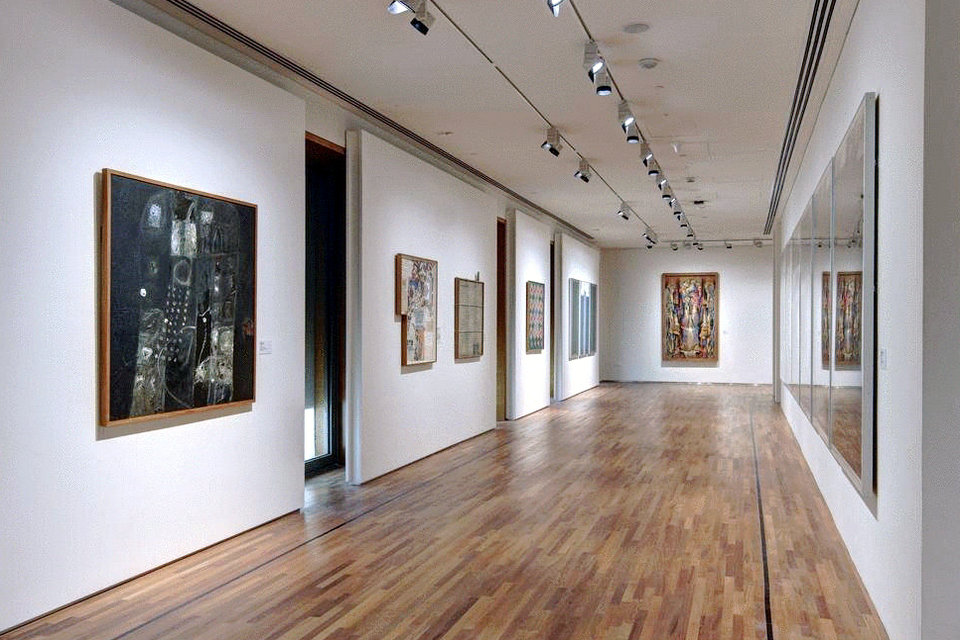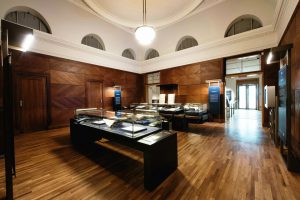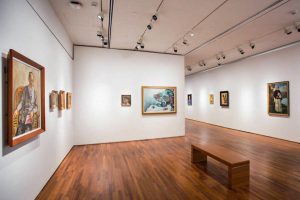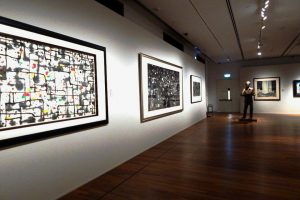Re:Defining Art (post 1970s). Artists in this period became more concerned with political and cultural issues, not just the form or appearance of an artwork. Using a wider range of approaches and materials, they experimented with other genres such as installation, video, photography and performance. Re:Defining Art exhibition in the UOB Southeast Asia Galleries 12 (on level 4),13,14 and 15 (on level 5).
The final thematic installment of “Between Declarations and Dreams” reflects how globalization began to transform Southeast Asian indigenous cultures in the years during and after the 1970s. As more artists began studying abroad, they experimented with new ways of making art; thus, in this section of the exhibition, visitors are confronted with an array of multidisciplinary works that include painting, video, installation and performance.
Works include early ventures into conceptualism, together with examples of avant-garde experimentation. On display are excerpted commentary and photographs from the provocative 1974 installation Towards a Mystical Reality by Malaysian artists Redza Piyadasa and Sulaiman Esa, a manifesto on the state of their country’s art at the time. Also on view is Indonesian artist Jim Supangkat’s Ken Dedes (1975), a hybrid of ancient and modern identities, in which the body of a historic Javanese queen has been grafted onto a modern female counterpart.
In order to speak about the 1970s and the subsequent development of art produced in this region, we begin instead a little earlier – in the 1960s. David Medalla, an England-based Filipino artist, had constructed an unusual piece of auto-kinetic sculpture which he called a bubble machine, for the 1964 exhibition Structures Vivantes: Mobiles/Images. This first bubble machine would set in motion the creation of an eventual openended iterative series of sculptures (each machine is never the same as the one before) which Medalla would call Cloud Canyons.
During this post-1970 period, artists also began to infuse their works with found objects in an attempt to spark social awareness. The central gallery’s focal point is a massive installation by the late Thai artist Montien Boonma, titled The Pleasure of Being, Crying, Dying and Eating (1993/2015), a Buddhism-inspired exposition on the nature of life. Its tower of precariously stacked ceramic bowls overwhelms the room, and it is flanked by equally energetic works that are commentaries on economic power and class: Hiding Rituals and the Mass Production II (1998–2000), a sensual form woven of rattan by Indonesia’s Nindityo Adipurnomo; and a ritual-altar-like installation of cloth and wood by Zulkifli Yusoff of Malaysia, entitled The Power II (1991). Nearby are video and stills from Performance (various years) by Indonesian performance artist Melati Suryodarmo, whose practice aims to incite awareness between the body and environment.
The final works of “Between Declarations and Dreams” lament the loss of heritage and tradition in the modern age, and often incorporate indigenous or craft-based mediums to convey a bittersweet nostalgia. One work by Thai artist Navin Rawanchaikul, Homage to Fon Pan-Ya (1995), comprises a glass cabinet filled with Chinese snuff bottles holding photos of elderly locals, thus transforming them into artefacts. Norberto Roldan’s assemblage Matriarch from Negros (1989) integrates Philippine native textiles and found objects as a chronicle of his country’s shifting cultural identity. This tendency to impose modern design and innovation onto traditional forms is also seen in Indonesian artist Heri Dono’s Wayang Legenda (1988/2015), a contemporary performance installation involving Javanese shadow-puppets.
Between Declarations and Dreams: Art of Southeast Asia since the 19th Century
What defines Southeast Asia and its art? From historical artefacts to contemporary perceptions of such objects, “Between Declarations and Dreams” traces the circuitous route of the region’s art, from its connection to 19th-century colonialism to its current reformulations of heritage, aesthetics and identity. The artistic journey through these galleries is a beautifully articulated progression, and the collection here establishes a lucid and distinctive framework for the Gallery’s fundamental aim: to advance the scholarly discourse on the history of Southeast Asian art. Given its detailed historical analyses and eclectic visual palette, “Between Declarations and Dreams” may best be savored over multiple visits.
Housed in the former Supreme Court building, the UOB Southeast Asia Gallery presents over 300 artworks that trace the shared artistic impulses across Southeast Asia. Starting in the mid-19th century, the exhibition navigates the art history of Southeast Asia as one that is characterised by a continuous encounter with the new as the regions artists negotiated the meaning of art and sought to reinvent vernacular expressions and aesthetics. Presented in a largely chronological sequence and punctuated by key turning points in artistic sensibilities, the exhibition also identifies how art is inseparably linked to the region’s tumultuous social and political history.
The title of the exhibition is credited to one of Indonesia’s most cherished poets, Chairil Anwar. In his poem of 1948, “Krawang-Bekasi”, Chairil Anwar laments the massacre of villagers in West Java by the Dutch colonial forces, giving vent to the desire for national independence at the time. This line may also be said to encapsulate the experiences of many artists in the region, caught as they are between declarations and dreams, the personal and the political.
The curatorial narrative explores four main themes places in a broadly chronological sequence, each one critically examining the shared artistic impulse of the region for each period: Authority and Anxiety, Imagining Country and Self, Manifesting the Nation, and Re:Defining Art.
This exhibition contains some artworks with potentially sensitive imagery. Visitor discretion is advised.
The UOB Southeast Asia Gallery, cultivate a deeper appreciation of Southeast Asia’s rich history and heritage and of developed as a region.
National Gallery Singapore
National Gallery Singapore is a leading visual arts institution which oversees the world’s largest public collection of Singapore and Southeast Asian modern art. Situated at the birthplace of modern Singapore, in the heart of the Civic District, the Gallery is housed in two national monuments – City Hall and former Supreme Court – that have been beautifully restored and transformed into this exciting 64,000 square metres venue. Reflecting Singapore’s unique heritage and geographical location, the Gallery aims to be a progressive museum that creates dialogues between the art of Singapore, Southeast Asia and the world to foster and inspire a creative and inclusive society. This is reflected in our collaborative research, education, long-term and special exhibitions, and innovative programming. The Gallery also works with international museums such as Centre Pompidou, Musée d’Orsay, Tate Britain, National Museum of Modern Art, Tokyo (MOMAT) and National Museum of Modern and Contemporary Art, Korea (MMCA), to jointly present Southeast Asian art in the global context, positioning Singapore as a key node in the global visual arts scene.
National Gallery Singapore oversees the world’s leading public collection of modern art from Singapore and Southeast Asia. It comprises over 8,000 works from the 19th and 20th centuries in all media, including painting, sculpture, printmaking, photography and video.
Aiming to be the centre for research, discussion and publication on the modern art of the region, the Gallery offers wide access and fresh understanding of our unique visual art heritage.
With its comprehensive collection, the Gallery presents the development of Singapore and regional cultures to tell their social, economic and political histories. The Gallery looks beyond national and regional boundaries of art to include a wider ambit of international visual arts culture, research into Asian heritage and cultural affiliations, and engage with global cultures and discourses.











